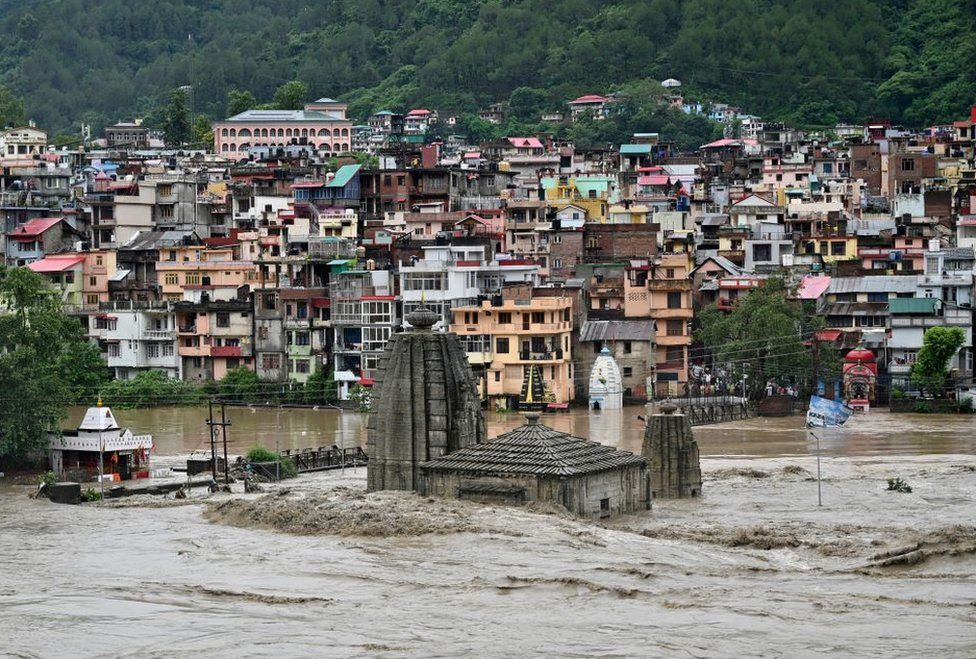“I saw our house falling. You can’t imagine how I felt.”
Forty-five-year-old Suman’s voice trembled as she recounted the harrowing sight of her family home collapsing on the day India celebrated its Independence on 15 August.
“I screamed loudly. But I couldn’t do anything,” she said, wiping tears.
Shimla, a town in the Himalayan state of Himachal Pradesh in northern India is known for its tranquillity and British colonial-era charm.
Suman’s family home, built after years of effort, was among several washed away in the torrential rains and landslides that hit the state this monsoon season.
“Our parents had put in their life’s savings to build this house,” Suman told the BBC from a relief camp, set up by the state government, where her family has taken shelter.
“To see this is unbearable. We don’t even want to build any house now. We have given up.”
Weeks of heavy rainfall have affected thousands of people across Himachal Pradesh and the neighbouring state of Uttarakhand, causing widespread destruction of life and property.
State government reports reveal at least 348 people have died due to rain-related incidents such as landslides and flash floods since June.
With nearly 80 deaths, Shimla, the capital of Himachal Pradesh, was hit particularly hard.
Chief Minister Sukhwinder Sukhu said the state’s loss exceeded 100bn rupees ($1.2bn, £961m), underscoring the magnitude of the destruction.
More than 2,220 homes have been obliterated while another 10,000 houses lie partially damaged. The wreckage extends to commercial spaces, with 300 shops rendered unusable.
The toll on livestock is equally devastating, with nearly 10,000 poultry birds and more than 6,000 cattle and various other animals dead.

The landscape bears the scars of 131 landslides and 60 flash floods the region has witnessed, altering its topography.
Roads in Shimla are blocked every few hundred metres by fallen trees or the heaps of mud and rocks that have tumbled off the hills.
Temple tragedy
People living in these hills are still reeling from the devastation that surrounds them.
On 14 August, 20 people died after a Shiva temple in Shimla was buried under a landslide.
One family lost seven members as the temple’s surroundings were inundated with slush, rocks and water.
The National Disaster Response Force (NDRF) and other rescue agencies launched an arduous search for survivors and bodies in the aftermath of the temple tragedy.

Sanjay Thakur lost his 17-year-old son Saurabh in the disaster.
“We heard the sound of a thunder that morning,” he said, adding that he ran towards the temple where his son was visiting.
- Fifteen die as heavy rains lash Indian states
- Dozens missing as India landslide search called off
“I saw that the building had fallen partially. A person stuck in debris was shouting for help,” he told the BBC. “We quickly rushed to rescue him. Then another landslide took place and earth from the rail tracks above the temple came down washing the temple away. There was nothing left.”
Locals helped the family look for Saurabh. They found his body the next day.
“I miss everything about my son,” he said. “His books are lying here. So are his clothes. Only he isn’t around. But nobody can do anything now.”

The devastation also shattered livelihoods of people like Akash Kumar, whose family relied on his meat shop for income.
The collapse of a state-owned slaughterhouse has left them without work.
“We used to get supplies from the slaughterhouse and then sell it at our shop,” Mr Kumar said. “But the slaughterhouse caved in and our house situated not far from there was declared endangered.
“We can’t figure out how we will earn our livelihood now and where we will eat,” he added.
His family includes his parents, four brothers and their wives and children – all of whom have now taken shelter in a rehabilitation camp in Shimla.
Fears of more havoc
After the landslides on 14 and 15 August, recovery efforts were underway in Shimla when another major landslide struck the state’s Kullu district on 24 August. Footage from the area showed buildings collapse like a house of cards.
The full extent of the damage caused by this landslide is yet to be determined. Officials say occupants of the buildings were evacuated a few days earlier.

But residents across Himachal Pradesh live in constant anxiety.
A massive thunderstorm that hit Shimla in the early hours of 23 August left locals sleepless and in fear.
“Lightning and thunder began around 3am,” says Rajesh Negi, a hotel worker. “We left our homes, fearing they might collapse any moment.
“We’ve never seen anything like this before,” he says. “Fear and stress have taken over our lives now.”
BBC News India is now on YouTube. Click here to subscribe and watch our documentaries, explainers and features.

Read more India stories from the BBC:
- India’s lunar rover takes a walk on the Moon
- India makes historic landing near Moon’s south pole
- At least 26 dead in India railway bridge collapse
- Fury in The Gambia over India cough syrup deaths
- A show taking on all that’s wrong with Indian weddings
Related Topics
- Floods
- Asia
- India
